
Director: John Badham
Release Date: 1979
Contains spoilers
Back in the halcyon days of video, when I was of a tender age, my Granddad (bless his soul) would happily rent any video I wanted to watch – age restrictions be damned. One video he rented for me, a video that was watched and watched until it had to be taken back to the store, was this version of Dracula. Now I most certainly had seen vampire movies before then, but this film sticks in my mind as the film through which I fell in love with the genre.
The film itself was based, like the 1931 Dracula, on the play by Hamilton Deane, yet this film not only skewed the book but also is very different to the ’31 film. Thus I can guarantee that, as this is a movie that has a very special place in my heart and as it is very different to its predecessor this is likely to be a long review that looks at the film blow by blow, so you will have to indulge me.
We begin aboard a ship tossed about in a violent storm. We see a sailor, his throat torn out, a gruesome beginning that, of course, bodes well. The remaining crew have gone to the hold and are trying to haul a crate out. They get it to the deck, as the captain ties himself to the wheel. They try to push the crate overboard, but a hand smashes through it, clawing out the throat of one sailor whilst his mate gets pushed overboard by a wave. The captain is alone as a wolf growls.
It is a dramatic opening and cuts out, completely, any Transylvania scene. This film is set in Whitby for the main, though actually the location shots where in Cornwall.
Next we see the lunatic asylum; it is the very essence of Bedlam. The inmates scream and it almost looks like a riot might occur. Seward (Donald Pleasence) tries to gain some order, wondering where his daughter Lucy (Kate Nelligan) is.
Lucy is in the house with her friend Mina (Jan Francis).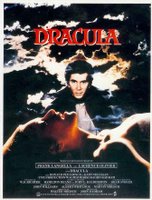 Now let us be clear, the roles of Mina and Lucy are reversed here from the normal roles. Mina is the sickly friend who will, very soon, be Dracula’s first core character victim. In a neat bit of plot twisting she is no longer Mina Murray, but Mina Van Helsing. It is Lucy who is engaged to Jonathon Harker (Trevor Eve). Lucy is portrayed as a very strong, intelligent woman, when we meet her she is reading a letter indicating that she has been offered a job with a solicitor’s firm.
Now let us be clear, the roles of Mina and Lucy are reversed here from the normal roles. Mina is the sickly friend who will, very soon, be Dracula’s first core character victim. In a neat bit of plot twisting she is no longer Mina Murray, but Mina Van Helsing. It is Lucy who is engaged to Jonathon Harker (Trevor Eve). Lucy is portrayed as a very strong, intelligent woman, when we meet her she is reading a letter indicating that she has been offered a job with a solicitor’s firm.
She is called to help her father and is in the asylum when a bell is heard and Mr Swales (Teddy Turner), the warden, says that it is ‘sunken bells’. In the book, of course, Swales was the old man befriended by Mina in the graveyard at Whitby. Mina also hears the bell and is drawn out of bed; she sees the ship in trouble. Despite her poor health, she runs out into the storm as the ship runs into rocks. She enters a cave and finds a survivor, though at this point we only see a hand emerging from a coat trimmed with wolf fur, it is Dracula (Frank Langella).
The next day the ship is being salvaged. Harker drives up the beach in his car, to an off screen comment about contraptions, he is a solicitor representing the Count. There is talk that the rights of the ship’s owner are sacrificed as the tiller is in the hands of a dead man, this is lifted from the book and not often quoted. It is revealed that the Count was taken to Carfax the previous night and his possessions are being taken from the ship to his residence by Milo Renfield (Tony Haygarth). This is a very different Renfield to the one we see in the ’31 film. He is gruff and has a grudge against Harker as he sold his house from under him. Seward, who is inspecting the body of the captain, asks Renfield to tell the Count that he is invited to dinner that evening.
Later we see Renfield pulling the final crate up the long stairs inside Carfax when Dracula awakens. He stands at the head of the stairs and transforms into a bat, swooping down towards Renfield and feeding on him. Carfax himself is a gothic vision of outlandish architecture, dust and cobwebs, owing much – I felt – to the interior of Castle Dracula in the ’31 film.
Lucy, Mina, Seward and Harker are discussing the shipwreck when Dracula arrives. It is mentioned that the ships log contains the word Nosferatu, which Mina believes means undead. The Count contradicts this and says it means ‘not dead’. This is an interesting piece of dialogue, perhaps indicating that Dracula is not overtly enamoured with his state. In a nod to the famous Harker/Renfield cutting their finger scene, during this scene Swales cuts his finger as he is carving and the camera lingers on him sucking the blood. There is also the famous “I do not drink… wine” line, but Langella delivers it in a much less obvious way than perhaps Lugosi did.
After dinner the Count is ‘attempting’ to read the log, but says that it is written in a dialect that he cannot understand. Mina falls into a faint, though it is clear to the viewer that it is Dracula’s doing through Langella’s subtle gestures. Seward calls for Laudanum but Dracula opposes the suggestion, saying that they should not pollute her blood and offers to hypnotise Mina to take away the pain she now feels. The hypnosis is successful, though Lucy makes it clear, during the process, that she dislikes the concept as Mina has no will of her own. Later Lucy, obviously interested in the Count just as Mina is, dances with Dracula – much to Harker’s chagrin.
That night Lucy sneaks from her and Mina’s shared bed to be with Jonathon. There is just the smallest amount of angst to underline that Harker has noticed the attraction between Lucy and Dracula, but then they kiss. The camera pulls up to the roof and we see Dracula crawl down the wall towards Mina’s room. Mist appears before the balcony door and a hand starts to claw at the lead around a pane of glass. Mina awakens, terrified as she sees Dracula’s face upside down, the pane falls and he opens the door – however that fallen pane is not mentioned again. Mina’s expression changes from terror to expectation and she opens her nightdress to reveal her throat.
Back at Carfax Renfield awakens. He tries to find water unsuccessfully and then eats a bug. Dracula appears and Renfield panics, trying to run, but there is no escape. Dracula tells him that he expects loyalty.
In the morning Lucy is woken by Mina trying to catch her breath. She calls her father, who, in a fantastic display of modern medicine, resorts to slapping Mina’s face but it is to no avail and Mina dies. They notice the punctures in her neck. Seward telegrams Van Helsing (Laurence Olivier). It must be said that making Mina his daughter causes the calling of Van Helsing to make much more sense than it did in the ‘31 film. That night Harker takes the deeds to Carfax for the Count to sign. Dracula asks him to take them to London immediately but Harker refuses saying he must attend the funeral. Dracula then pens a letter inviting Seward and Lucy to dinner, after the funeral, telling Harker that he would be invited also but obviously he would be on route to London.
It must be said that making Mina his daughter causes the calling of Van Helsing to make much more sense than it did in the ‘31 film. That night Harker takes the deeds to Carfax for the Count to sign. Dracula asks him to take them to London immediately but Harker refuses saying he must attend the funeral. Dracula then pens a letter inviting Seward and Lucy to dinner, after the funeral, telling Harker that he would be invited also but obviously he would be on route to London.
Driving back from Carfax, Renfield lunges at Harker from the back seat of the car. It seems like an attack but Renfield does cry out for Harker to save him. Renfield is institutionalised for his trouble.
The next day sees the funeral of Mina. Afterwards Harker tries to get Lucy to go to London with him, but she refuses. Seward mentions that Van Helsing is arriving that night and so they would not be able to dine with the Count. He’s forgotten to mention the invitation to Lucy before then but she quickly insists that she will dine with the Count. We see Lucy arrive at Carfax as Seward meets Van Helsing at the station. Carfax is aglow with candles.
During dinner we see Dracula begin to flirt and then seduce Lucy. During these scenes we hear the famous ‘children of the night’ line, but slightly changed. Now Dracula says “Listen to them - children of the night. What sad music they make.” The line was changed deliberately as part of the attempt to make Dracula seem to dislike his lot in life, envy the sunlight walking mortals and make him a tragic figure.
Interspersed between these scenes we see a figure in white smash through a window and hear cries from Annie (Janine Duvitski), one of the inmates I assume, about her baby. Seward and Van Helsing find the baby, punctured and drained of blood. Annie is hysterical, talking of red eyes and fangs, but manages to say it was Mina.
The next day we see Van Helsing reading a book on vampire bats, he then visits Mina’s grave and places garlic across it. Lucy approaches him and he gives her a crucifix to wear. As they are leaving Dracula arrives, on horseback, to ‘pay his respects’ to Mina. From the house Van Helsing sees the horse rearing at the grave and that gives him an idea. He takes a white horse to the graveyard, along with an incredulous Seward. The horse goes to Mina’s grave and begins to stomp at the soil and then dig at it with its hooves. This is a marvellous moment, to my knowledge not done in other Dracula movies. This is based around folklore, and if we look at Everything You Need to Know About Vampires we see the following ways of finding a vampire’s grave:
· Have a virgin boy ride naked and bareback on a virgin stallion through the graveyard until the horse steps on a grave and goes no further. That marks a vampire’s grave. Or...
· Lead a white stallion through a graveyard and the grave he will not step on is the grave of a vampire.
The film seems to have merged the two concepts, but it is marvellous that such folklore has been added into the movie.
Meanwhile Lucy has removed the cross. Dracula enters the room, he bites her and there is a stylised love scene complete with silhouettes and red glowing graphics, finally he has her feed from him.
Seward and Van Helsing have dug up Mina’s grave and it is empty. Van Helsing sees that the side of the coffin is broken and Seward realises it goes into the mines that run under the town. Van Helsing leaves Seward by the grave as he descends into the mines. A bat flies at him and he drops his crucifix into a puddle of water. As he gropes for it we see, reflected in the water, a grim vision. Many have complained about this scene as vampires cast no reflection (a device used twice later in the film) but it does look good. According to the ‘making of’ featurette, Badham liked the scene and invented the rule that vampires do cast reflections in holy water and, as the cross had fallen into it, the pool had become holy water. A little flimsy perhaps!
It is, of course, Mina.  She looks like something from Hell, her face greyed and covered in mud, her mouth stained with blood and her eyes red surrounded by deep black shadows. She stumbles forward repeating the word Papa. Suddenly she is on Van Helsing but is pulled away by Seward who threatens her with a cross. The cross burns her flesh and she turns away, onto Van Helsing’s stake; the distraught father wails.
She looks like something from Hell, her face greyed and covered in mud, her mouth stained with blood and her eyes red surrounded by deep black shadows. She stumbles forward repeating the word Papa. Suddenly she is on Van Helsing but is pulled away by Seward who threatens her with a cross. The cross burns her flesh and she turns away, onto Van Helsing’s stake; the distraught father wails.
Harker has returned from London and finds Lucy collapsed on the floor, wounds in her neck. Van Helsing orders garlic rubbed into the windows and doorjambs and then goes downstairs. He is confronted by Dracula, who casts no reflection and so smashes the wall mirror. Van Helsing presents him with garlic, causing him to rear away. Dracula tries to dominate his will but Van Helsing is too strong. Eventually Dracula escapes the room as a wolf.
Next day Mina’s body is in the graveyard. She now looks fresh and beautiful again. Van Helsing shows the incredulous Harker that she has no reflection in the mirror. He then cuts out his daughter’s heart. They return to the house but Lucy has gone.
They chase down her horse and trap in Harker’s car and she is incensed at their interference. Seward takes her home whilst Harker and Van Helsing go to Carfax. They open Dracula’s coffin, but it is empty. Although this film insists on maintaining the inaccuracy that Dracula cannot walk around in daylight, he is not restricted to his coffin - as the mobile Dracula delights in telling his hunters. Harker threatens him with a cross that Dracula grabs causing it to burst into flames. He then turns into a bat and attacks Harker, retreating only when Van Helsing breaks a support to allow sunlight into the crypt.
After placing hosts in the crate they return to the house to discover that Seward has put his daughter into a room of the asylum. Harker goes in to see her alone. She is conniving at first and then seductive. As she holds Harker she vamps out and tries to bite him.
That night Dracula returns, he scales the wall to Renfield’s cell and breaks his neck, then, whilst in the form of mist, he enters Lucy’s cell. There is a crash and, by the time the door is opened, they are gone, a hole smashed into the solid wall. They try to give chase and we have a chase scene car against horse drawn wagon. Eventually they crash, but they have discovered that the wagon was going to Scarborough. They reach there too late, a ship has already set sail with the crate aboard, but Harker and Van Helsing commandeer a boat and give chase. They board the fleeing ship and go to the hold, finding the crate with Lucy and Dracula inside. Van Helsing is about to stake the Count when Lucy awakens and her cry warns Dracula. In quite a turn around Dracula pins Van Helsing (or a body double at least as Olivier was very frail when the film was made) to the hull of the ship with his own stake. Harker tries to shoot Dracula, to no avail. With his dying breath Van Helsing swings a hook on a rope into Dracula’s back and Harker pulls the winch that drags Dracula into sunlight. His death is graphic, filled with screams, his flesh peeling away in the sun.
At the end we see his cape flutter away, or do we? It seems to glide rather than flutter and the camera cuts to Lucy, a smile curling over her lips. Is it because she is free from the Count or, as she went willingly to him, is it because he has escaped?
It seems to glide rather than flutter and the camera cuts to Lucy, a smile curling over her lips. Is it because she is free from the Count or, as she went willingly to him, is it because he has escaped?
This film is a visual treat, with a stellar cast who give it their all. The soundtrack is marvellously stirring. Badham strayed from both the source and the ‘31 film/play but what he did really works. He really did try to give this a very romantic edge and I believe that it worked better than Coppola’s version with the clichéd reincarnation of the true love plotline. This, as you probably can tell, is one of my favourite versions of Dracula and so, of course, I will score it highly. When I re-watched it for the review I tried, though I do not know if I succeeded, to be objective about it and settled on 9 out of 10.
The imdb page is here.
Sunday, May 14, 2006
Dracula {1979}- review
Posted by
Taliesin_ttlg
at
1:15 AM
16
comments
![]()
Saturday, May 13, 2006
Dracula - audiobook
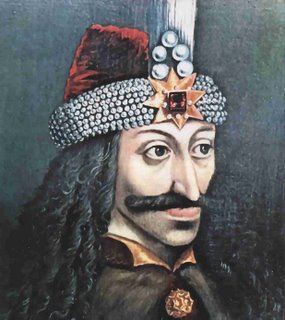
LibriVox have released the community audiobook of Dracula.
The mission of LibriVox is: "LibriVox Volunteers record chapters of books in the public domain and publish the audio files on the internet. Our goal is to record all the books in the public domain."
A worthy cause.
Many thanks to LibriVox, and all the volunteers, who gave up their time to make this classic work available. I'm downloading right now!
Posted by
Taliesin_ttlg
at
2:12 AM
0
comments
![]()
Night Watch - Theatrical Release - review

Director: Timur Bekmambetov
Release Date: 2004
Contains spoilers
Night Watch or Nochnoy Dozor is a fantasy action movie, whilst it is not primarily a vampire movie it certainly involves vampires. The UK DVD is a two disc set, disc one has the film is Russian, with subtitles, and in English Dub. This review, however, is of the version of the movie on Disc 2, which was the UK theatrical release.
The Theatrical release was in Russian with subtitles, but those subtitles were something special. There is a scene with a young boy, Yegor (Dmitry Martynov), swimming that I have screen captured to illustrate this. As he swims his nose starts to bleed as a vampire summons him. Notice the first subtitle, in red like his blood as she says “come”, then notice the second screen capture as the word “come” begins to break apart swirling like his blood in the water.


At other times, say when a character is having trouble speaking, the subtitles might fade in and out as they speak or subtitles of shouted words might rush larger and larger towards the screen. Never is it impossible to read the subtitles, but the subtitles are very much part of the film and I would urge anyone buying the DVD to watch the theatrical release rather than the plain subtitled or dubbed version.
The film starts in the dark ages. We discover that there is a type of people called the others, human but with special powers. These others were split into two factions, the dark brought suffering to humanity and the light tried to defend humanity. One day the forces of light, led by Geser (Vladimir Menshov), and the forces of dark, led by Zavulon (Victor Verzhbitsky), met upon a bridge and a battle ensued. Geser realised that the two armies were equally matched, stopped the battle and a truce was called. No-one, from that day, would be forced to join dark or light, the choice must be by free will. The light would form the Night Watch to police the dark and the dark would form the Day Watch to police the light in return. Prophecy told that there would come an other, more powerful than the rest, who would chose dark or light, breaking the truce and tipping the balance forever.
Cut to 1992 and a young man, Anton (Konstantin Khabensky), goes to a witch (Rimma Markova) as his wife has left him. He is told that she can return her to him but his wife carries a child, not his, that will draw her away again. The witch can cause the wife to miscarry but the sin will be his. He agrees, but then panics. Suddenly Night Watch officers burst into the room to stop the witch. They are in a place called the gloom; a deadly world of shadows parallel with our own that only others can enter and see, yet Anton sees them. They prevent the witch finishing her ritual and realise that Anton is an other, he is a seer.
Twelve years later Anton is a Night Watch officer, having chosen the light. He is sent to track down a vampire, Andrei (Ilya Lagutenko). Andrei’s newly turned girlfriend, Larisa (Anna Dubrovskaya) is using “the call” to bring Yegor, from the swimming pool, to them. Anton can find them by drinking pig’s blood, only drunk when tracking vampires, and tuning into the call. Whilst following the boy he sees a woman, Svetlana (Mariya Poroshina), and has a vision of a vortex and a plane crashing. Finally he tracks the vampires down, just before they feed. After a bloody struggle he kills, rather than arrests, Andrei and Larisa escapes.
Night Watch discovers that Svetlana is ‘the virgin’; a woman cursed who, prophecy says, heralds the final battle between light and dark. Anton is sent to discover who cursed her, to try and prevent that battle. He wants to protect Yegor who, he discovers, is his ex-wife’s son. However, whilst he tackles Svetlana, Larisa – at the urging of Day Watch – has captured the boy and demands to see Anton.
This is a brief precise that I hope, other than revealing some of the mythology and major plot points, 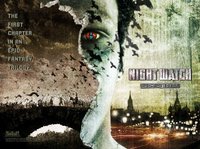 will not have given too much of the ins and outs of the plot away. This film is a joy. Some have told me that they found it difficult to follow but I suspect that had a lot to do with getting hold of the Russian DVD, on which the English subtitles are poor to say the least. The film is inventive in all the right ways; I was most taken with the way that Zavulon augured events using a mortal combat type video game. It is also amusing to watch Yegor, after his first brush with the vampires, sharpening a stake whilst watching the Buffy episode “Buffy vs. Dracula”.
will not have given too much of the ins and outs of the plot away. This film is a joy. Some have told me that they found it difficult to follow but I suspect that had a lot to do with getting hold of the Russian DVD, on which the English subtitles are poor to say the least. The film is inventive in all the right ways; I was most taken with the way that Zavulon augured events using a mortal combat type video game. It is also amusing to watch Yegor, after his first brush with the vampires, sharpening a stake whilst watching the Buffy episode “Buffy vs. Dracula”.
The special effects are good throughout. Some of the set pieces are excellent, such as when Night Watch officers are speeding through the city in their turbo-charged van and suddenly Zavulon is in the street before them and their van flips over him. The fight between Anton and Andrei is brutal and, unlike many films and series of this type, these guys have not suddenly become expert martial artists. It is an old fashioned slug-fest, using whatever comes to hand.
Exposition in the movie is good, but not too in your face, leaving some issues up to the audience to sort out in their own minds from the visual clues. This, however, is not a problem; it is more a case of the director not treating the audience like children. There is not necessarily a definitive ending, more an episode conclusion/cliff hanger as this is designed to be the first film in a trilogy. It must also be said that the two main plot threads are not interlinked, except in the highest sense of the oncoming battle between light and dark.
I enjoyed this film at the cinema, but was worried that a second viewing might prove less fulfilling, on the contrary, if anything I got more out of the movie. I’ll happily give this film 8 out of 10.
If you go to the official site there is both a trailer and the whole film to watch (condensed into 2 ½ minutes).
The imdb page is here.
Posted by
Taliesin_ttlg
at
1:41 AM
0
comments
![]()
Labels: vampire
Friday, May 12, 2006
Shower of Blood - review

Director: Tiffany Kilbourne
Release Date: 2003
Contains spoilers
Shower of Blood opens with a girl running through the woods, an uneven steady cam provides a “Blair Witch” feel until the camera finds the girl on the floor covered in blood. Cut to the opening credits with the naked torso of a woman imposed through the credits, her hand caressing her body, eventually caressing the blood which spills across her flesh. This sets the scene for a film, which feels that replacing script, story and acting ability with T&A makes a movie passable.
A radio news programme informs us that a woman in her early 20s is missing, police refusing to speculate if it is connected with a series of mutilations tied with cannibalism that has plagued Galloway County.
A group of young college kids are parked in a van, lost in the woods. One girl, Megan (Robin Denise Brown), is being sick due, we assume, to too much beer. In the van are Terry (Peter Ranaud) – Mr “I’ve got your {insert noun} right here” as he clutches his groin - , Kurt (Dave Larsen) – Mr I can crush beer cans on my forehead -, Heather (Melissa Mountifield) – Miss, I’m a virgin and don’t know whether to give it away and Lisa (Lia Montelongo). Lisa is the niece of Uncle Marty (Martin Shannon) and it is to his cabin (or mansion) in the woods that the friends are going, hoping to stay the night before going on to a concert.
I hope by the above description I have adequately described the sheer amount of stereotype and cliché going on here. What I haven’t put across yet is the risible quality of the script, the sub-porn acting when delivering the lines and the inexplicable use of belch and fart noises that pepper the film.
The friends reach the cabin, the soundtrack here plays a song which I believe is a track called “In comes the night” by the Bad – this is a band I’d never come across but the song was the shining jewel in this film. Uncle Marty does not appear to be in but Lisa finds a key and lets the friends in. Cue lots of poor bedroom farce, rank acting and gratuitous nudity featuring plenty of silicone; during this Lisa starts experiencing visions often involving roses and blood. Uncle Marty eventually appears, he is, of course, a vampire. He vamps out on Megan – who he eventually cooks and serves up to the friends. Eventually the two guys are turned as he hunts the two remaining girls.
The film seems to be a little confused as to how it wants to go here. At first it is apparent it is all about his niece, but suddenly shifts into making Heather his bride, using a ritual called the shower of blood – this involves Lisa’s blood.
The plot makes very little sense and is so riddled with cliché that it becomes more and more painful the more you watch. There is the use of digital effect, but these seem so out of place that it jars. For example the digital build of fangs as they emerge just looks silly and not impressive.
The film makers obviously had a few ideas, but lacked the ability, the confidence or the budget to pull them off. Oh, I never again want to see a vampire dancing to “Roll out the barrel”, a tune that seems to become his theme tune later. The twist ending is so obvious that it would have been a more impressive twist not to do it! The film is, by dint of some of the content, an exploitation movie – unfortunately it is the audience who are being exploited.
A poor effort, 1 out of 10.
A trailer is available here.
The imdb page is here.
Posted by
Taliesin_ttlg
at
2:56 AM
0
comments
![]()
Labels: vampire
Wednesday, May 10, 2006
Blacula - review

Director: William Crain
Release Date: 1972
Contains spoilers
The vampire genre enters the world of blaxplotation in Blacula. The film begins in Transylvania in 1780 and dignified African Prince Mamuwalde (William Marshall) and his wife Luva (Vonetta McGee) have visited Castle Dracula. They attempt to gain the Count’s support to try and convince the European heads of state to end the slave trade. Dracula is dismissive, believing that there is nothing wrong with slavery. Disgusted by his host’s attitude Mamuwalde tries to leave but Dracula prevents him. Mamuwalde is overpowered by Dracula’s servants and then the horror of castle Dracula becomes apparent when a group of Brides enter the room.
A moment here to describe the brides, they have to have some of the worst vampire makeup effects seen in a movie. Their faces are falsely grey and they have comedy fangs. This is not just in this section of the film; all the vampires in the movie have the same image problems – except certain ones. For some reason the key vampires, and those who for plot reason must pass as human, don’t undergo this comedy transformation.
Dracula curses Mamuwalde with vampirism and then locks him in a coffin so that he may never taste blood. Dracula also gives him his name, sort of, and names him Blacula. He locks Mamuwalde in a secret room, with Luva by the coffin so that she might hear his agony until she dies.
Cut to the present day and two interior decorators, Bobby McCoy (Ted Harris) and Billy Schaffer (Rick Metzler) buy the contents of castle Dracula, including aforementioned coffin, and ship the lot back to LA. Bobby is opening 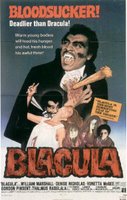 the coffin when Billy cuts his arm. Blacula arises and feeds on the two men.
the coffin when Billy cuts his arm. Blacula arises and feeds on the two men.
At the funeral home, where Bobby has been taken, Tina (Vonetta McGee), her sister Michelle (Denis Nicholas) and Michelle’s boyfriend Dr Gordon Thomas (Thalmus Rasulala) come to view the body. Gordon is with the Scientific Investigation Division and is asked to look into the death. He notices the puncture wounds and the fact that the body seems drained of blood and becomes suspicious. Blacula is watching from the wings and spots Tina. He realises that she is the reincarnation of Luva.
What follows from there is fairly unoriginal vampire fare as Blacula tries to woo his reincarnated love and Gordon takes on the Van Helsing type role.
The film is fairly typical of an early 1970s blaxploitation movie, complete with a soul musical interlude and more stereotypes than you could shake a stick at, but what is it like as a vampire movie.
The storyline might be a little hackneyed but it is functional enough. Tina, in her heart, recognises her love and a rash of vampires spring up through the city as a bite and death is enough to turn a victim.
The film does fail to produce much in the way of tension. There is one scene when Gordon and his police lieutenant buddy, Jack Peters (Gordon Pinsent) enter what they think is Blacula’s lair. The place is filled with all those turned as vampires and they have gone in there with a couple of cops. One of the cops, Barnes (Logan Field), is known to the audience to be a vampire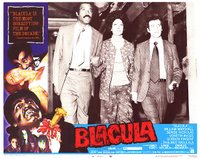 – he’s one of the ones that doesn’t have the awful grey face paint on, so his nature is unknown to the two heroes. Unfortunately this is not exploited by the director in any real sense, when it could have been used to create a sense of peril and seemed a little pointless.
– he’s one of the ones that doesn’t have the awful grey face paint on, so his nature is unknown to the two heroes. Unfortunately this is not exploited by the director in any real sense, when it could have been used to create a sense of peril and seemed a little pointless.
There is an effective scene, however, when turned taxi driver Juanita Jones (Ketty Lester) is taken out of the deep freeze in the morgue and thaws out. She comes screaming down the hall like a banshee (sorry for mixing my monster metaphors) and it is a fantastic scene.
Blacula, himself, sprouts a large amount of facial hair when he vamps out and has the ability to turn into a bat. The bat transformation seemed pretty good generally and, unlike hammer films of the same period, didn’t look utterly pathetic – so kudos to the film-makers for that.
All in all, as a vampire film, this is fairly pedestrian, never really raising itself above average. Don’t get me wrong, it is not a bad film and is worth a watch but it isn’t one to go nuts over, especially if you want scares as it seems to be played out much more for laughs. 5 out of 10.
The imdb page is here.
Posted by
Taliesin_ttlg
at
3:41 PM
4
comments
![]()
Tuesday, May 09, 2006
The Night of Scarlet Terror

A new version of Carmilla is in production. By the looks of things it has a very Euro 70's feel.
The synopsis from the official site states:
In 1970 two young lovers cross paths with a mysterious Countess. She invites them to spend the night at her home in the country. They arrive with another young friend. The night becomes a psycho-sexual psychedelic nightmare that will not stop. Some escape her, but for how long can they evade she whose passion for blood is beyond the limits of time and space?
A teaser trailer is available for download.
Posted by
Taliesin_ttlg
at
3:03 PM
0
comments
![]()
Aswang - review
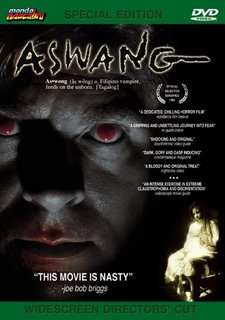 Director: Wrye Martin / Barry Poltermann
Director: Wrye Martin / Barry Poltermann
Release Date: 1994
Contains spoilers
The Aswang is an unusual form of vampire, hailing from the Philippines, and this is one of the few films made about such a creature (another being the film also entitled Aswang two years earlier but, as far as I am aware, never released with English dubbing or subtitles). I shall look into this particularly nasty creature later in the review, but suffice it to say in this film the aswang primarily feeds on unborn children, using a long, proboscis like tongue to enter the pregnant mother.
The film begins in a solicitor’s office where Katrina (Tina Ona Paukstelis) is signing the rights to her unborn child to Peter Null (Norman Moses) and his ‘wife’.
Seven months later he is driving Katrina to his family estate, where she is to pose as his wife, Janine, until the baby is born. He has told her that his family has not met Janine but he will never receive his inheritance if he has no heir. At the home they meet his mother Olive (Flora Coker) and their maid, who came from the Philippines where Peter grew up, Cupid (Mildred Nierras). He also has a sister, Claire (Jamie Jacob Anderson), but she lives in a cabin behind the house and Katrina is told to avoid her as she is ‘touched’.
That night at dinner Olive, who is in a wheelchair and needs oxygen, has what can be best described as a funny turn. Rather than help her mistress, Cupid listens to Katrina’s belly and says, in her native language, that it is only a couple of days and it is nearly ripe. During dinner Katrina tries to refuse a drink but is told that it is only apple cider, as the night goes on she gets steadily more and more drunk – a little confusing to me, though I believe that in America apple cider is none alcoholic generally, an alien notion to us Brits.
That night Katrina dreams, strange and disturbing visions fill her head. The camera pulls from the dream and we see Peter with his head buried between her legs. In the morning he announces to his mother that it is a girl.
During this we have seen a man with his dog in the woods. He has found several cocoons, each containing what appears to be a desiccated foetus. The next day he appears near the manor house. Peter is incensed but Katrina invites the man to dinner. He is Dr Harper (John Kishline). After dinner he looks at some of the paintings and spots one with a demonic creature above a hut, its long tongue entering the building. He gets back to his cabin and finds the picture in a book, it is a depiction of an aswang, the inscription tells us that they suck the life out of unborn children, but some of the unborn survive to become aswang themselves. He realises he hasn’t seen the dog, finds it hung and dead and then is struck and strangled by a long tongue. Later we see his blood being fed upon, with the tongue beneath the skin of his arm, and him being cocooned.
In the night Katrina wakens to find a long tongue probing across the bed she pulls at it and a window shuts, hanging Olive from the window. Unfortunately, here, the film falls back on staple horror clichés. Katrina escapes the house and, rather than runs, goes to Clare’s cabin. Clare attacks her with a chainsaw, in a rather pathetic attempt on Katrina’s life who easily dispatches her with a hoe. She then realises that Clare had posed as Peter’s wife in the solicitors. We have the obligatory escape, picked up by sheriff, returned to house scene – though the sheriff later realises something really is wrong, returns and is quickly killed.
The clichés are countermanded by the two main performers, Katrina does seem terrified as she is chased around the estate and Peter seems entirely psychotic, especially as he paces around singing “she’ll be coming round the mountain” or begins screaming about the fact that America has laws, and he has bought the baby, ignoring of course the laws regarding infanticide. We also realise that Katrina is unnaturally strong and resilient, how else, when chained, could she chop her own hand off with a hand-axe in order to escape and then manage not to bleed to death until the finale.
All that said, the film is effective. Whilst most of the cast have been in this one film and many of the performances are low grade, and the script falls back on horror cliché, not to mention the special effects which, quite frankly, are terrible, the film delivers. It is a shame about the effects, especially the tongue which, with some budget, might have been done in an animatronic sense (or perhaps even some digital wizardry). Unfortunately it looks like a painted piece of tubing – as the main point of the film this is disappointing.
Yet, as I said the film does deliver. There is a palpable sense of tension, helped greatly by a very moody soundtrack. The taboo nature of the vampire’s food-source helps also, causing the viewer to cringe. If only the more interesting and conspiratorial aspects of the early part of the film had not been abandoned for run of the mill shlock horror later.
The aswang itself is not necessarily accurate to the Philippine myth. Firstly the aswang is a collective name and there are different types. Some, however, are vampiric, and some of these do have long tongues with which to feed and like small children as a preferred food source, though not necessarily always unborn children. These parts of the film fit pretty much in with some of the myth but the vampiric aswang is also depicted as a shape-shifter. It was probably for the best that this part of the myth was avoided given the budget. It is also common for the vampiric aswang to take the form of young women, not something the film acknowledges. For more on the aswang click here.
When settling on a score I was torn between the fact that the film is clichéd in places, has some very poor acting and terrible effects and the opposing factor that this is a fairly unique movie (certainly in western cinema) that is genuinely disturbing, leaving the viewer uncomfortable in places for all the right reasons. In the end I settled for 5 out of 10, an average score.
The imdb page is here.
Posted by
Taliesin_ttlg
at
11:04 AM
0
comments
![]()
Labels: aswang
Monday, May 08, 2006
A Dracula Sequel
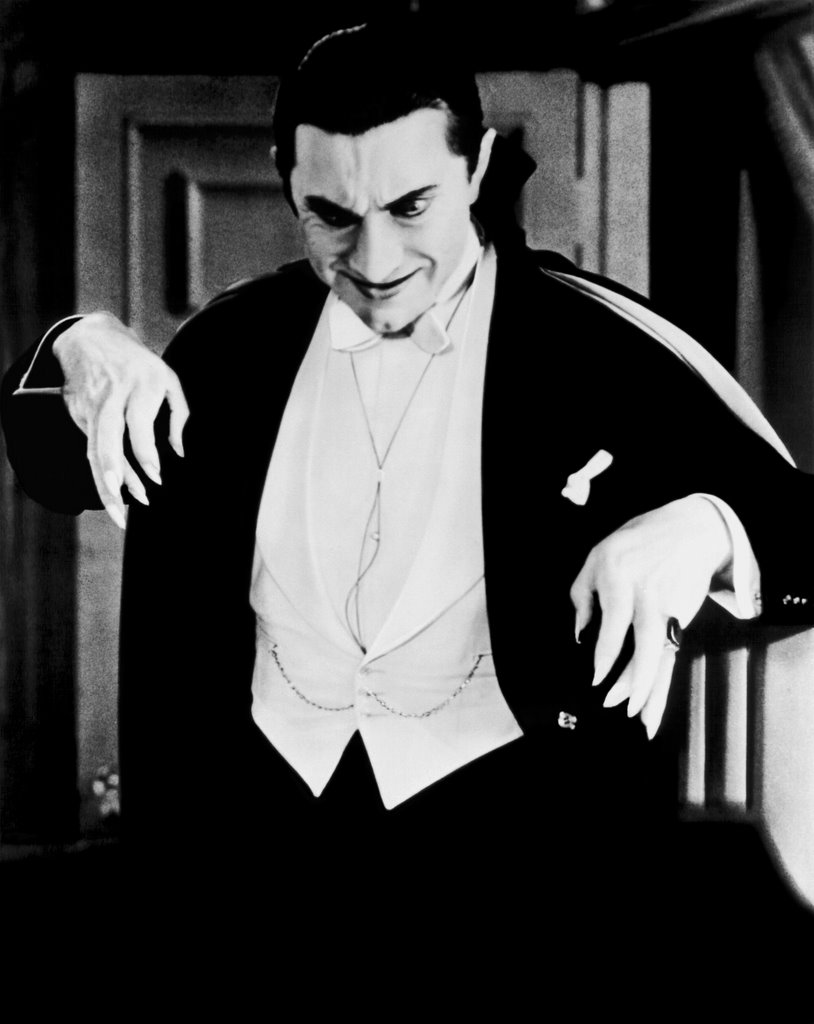
In what can only be described as synchronicity, given I’ve just posted a review of Dracula (1931) , there is to be a sequel to Dracula filmed.
The Mystery of the Haunted Vampire has reported on this so nip over there to read the detail and get the links. Folks may wonder why fuss over this, the character has appeared in more films and books than you can shake a stick at. Suffice it to say that this is the first script officially sanctioned by Stoker’s estate since the 1931 Lugosi movie. More news as it appears.
Posted by
Taliesin_ttlg
at
8:29 AM
2
comments
![]()
Sunday, May 07, 2006
Dracula {1931} - review

Director: Tod Browning
Release Date: 1931
Contains spoilers
This is one of the most famous screen adaptations of Dracula and stars Bela Lugosi as the Count.
For those unfamiliar with the film, a quick synopsis is in order. Renfield (Dwight Frye) travels in secret to Transylvania to complete a real estate deal with Count Dracula. Dracula is buying Carfax Abbey in England.
They are carried back to England on the ship the Vesta, and by now it is clear that Renfield’s mind has completely snapped and he is completely in Dracula’s thrall. When the ship docks all the crew are dead and the only survivor found is Renfield. He is committed to Seward’s Sanatorium, next door to Carfax.
In the theatre Dracula introduces himself to Dr Seward (Herbert Bunston), who is there with his daughter Mina (Helen Chandler), her fiancé John Harker (David Manners) and Mina’s friend Lucy Weston (Frances Dade).
Lucy is soon dead, like many others she has lost much blood and has two small marks on her neck. Professor Van Helsing (Edward Van Sloan) is consulted and suspects a vampire. He quickly realises that Dracula is the fiend, but Dracula has already set his sights upon Mina.
The film is a minimalist’s dream. Normally the soundtrack to a film helps develop the atmosphere. Dracula has no real soundtrack, except over the opening credits and yet still manages to conjure a thick atmosphere. The DVD has a new soundtrack created by Philip Glass as an option, and yet I do not like to play that soundtrack whilst I watch the film, as I feel that it can make the film feel cluttered.
In much the same way Lugosi has very little dialogue. All the famous lines are there, yet it is Lugosi’s presence that gives the character his edge. The perfect illustration of this is when the brides stand above Renfield’s fainted form. Dracula dismisses them without a word, just a glance and a gesture, and yet we can feel his authority, a testimony both to Lugosi as actor and Browning as director.
It has to be said that the death, and undeath, of Lucy is so glossed over that in many respects it is not even minimalistic, it is more an irrelevance.
It is interesting to note that the film diverts away both from the book in many ways, including both the roles and names of key characters as well as plot, but it also diverts from what we would normally associate with the vampire, and more specifically Dracula, mythology.
The ship Dracula takes to England is called the Vesta and not the Demeter. This is a change from referencing Demeter, Goddess of agriculture, to referencing Vesta, Roman Goddess of hearth and home – though in truth the name change probably means very little.
In Dracula’s castle we see armadillos. The creatures are not normally associated with the vampire myth; indeed there is no reason why they would be in Eastern Europe as they are native to the Americas. 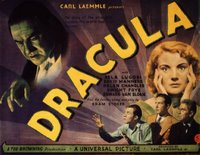 Interestingly Mick Farren, in his vampire series the “Renquist Quartet” published between 1998 and 2004, lists the armadillo as being sought after by vampires as a source of good luck.
Interestingly Mick Farren, in his vampire series the “Renquist Quartet” published between 1998 and 2004, lists the armadillo as being sought after by vampires as a source of good luck.
One noticeable change to the mythology is that Van Helsing tells Dracula that, even if he cannot save Mina’s life, he knows how to save her soul. Dracula retorts that he can save her soul if she dies by day, but he will ensure she dies at night. This is quite a rarity in the mythology, indeed I cannot think of another film that uses such an idea.
One intriguing line from Dracula comes in the theatre when Lucy quotes an old toast about the dead. Dracula replies, “To die… to be really dead… that must be glorious.” Within that one line we discover a creature almost at odds with his unnatural existence.
Most interestingly garlic is not used at all in the film. Van Helsing uses wolfsbane to ward off the vampire – a herb more commonly associated with the werewolf myth.
The two most notable performances in the film are those of Lugosi, for sheer presence, and Frye. His performance as Renfield is utterly fantastic and is reason enough to watch this film. The menace in his voice as he declares, “You know too much to live, Van Helsing!” is palpable.
The film does have problems, watching it with fresh eyes. Its minimalism can mean that exposition is lacking, leaving the viewer to fill in blanks. We know Van Helsing has been consulted regarding the mysterious deaths and yet the film never explains why, not even with a throw away line. We assume that Van Helsing has “taken care” of Lucy and yet we really do not know.
Yet at other times that minimalism works in the film’s favour. Whether it is Renfield holding a conversation with a silent Dracula or Mina holding a conversation with ‘someone’ as a bat flies around the terrace, we are left in no doubt about Dracula’s telepathic abilities.
Some might complain that I am giving this a score of 8 out of 10, it might be argued that this is a classic and should get higher and yet I don’t feel the film deserves any more. The film is certainly iconic, groundbreaking and influential, and it is a necessary addition to any vampire genre fan’s collection, and yet, in some respects, it is a flawed classic.
The imdb page is here.
Posted by
Taliesin_ttlg
at
11:22 PM
9
comments
![]()
Coming Soon: Perfect Creature
 A New Zealand movie, due soon, set in an alternate world where vampires are the next step of evolution and co-exist peacefully with humanity. However, when an influenza epidemic starts tearing through the human population one vampire begins feeding on humans.
A New Zealand movie, due soon, set in an alternate world where vampires are the next step of evolution and co-exist peacefully with humanity. However, when an influenza epidemic starts tearing through the human population one vampire begins feeding on humans.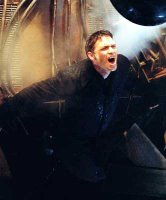 The church sends an agent to hunt him down and the agent teams up with a human cop.
The church sends an agent to hunt him down and the agent teams up with a human cop.
My first reaction was that it sounds a little like “the Breed” (2001), but we will see. The production company site has some scant detail but there is no release date as of yet, nor is there a trailer. There has, however, been one still released that I can find.
Posted by
Taliesin_ttlg
at
10:06 AM
2
comments
![]()
Underworld (Special Extended Edition) - review
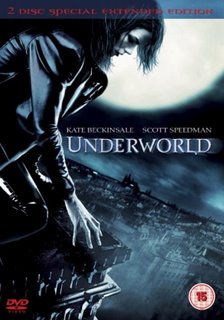 Director: Len Wiseman
Director: Len Wiseman
Release Date: 2003
Contains Spoilers
This film begins with Selene’s (Kate Beckinsale) voice-over as she looks out across the city. The cinematography is wonderfully moody; the night is tinged with blue to allow the viewer to actually see what is occurring in the dark. We discover the Selene is a death-dealer, a vampire trained to hunt lycans – werewolves to you and me – in the ongoing war between the two species. The lycans are few in number now, following the defeat centuries earlier of the leader Lucian (Michael Sheen), but those left are powerful, their changing no longer dictated by the moon.
From their lofty vantage spot the vampires spot two lycans heading towards a subway – in human form – and leap down from the building ready for the hunt.
In the subway, Selene catches the eye of Michael (Scott Speedman) and then one of the lycans, Raze (Kevin Grevioux), opens fire across the crowded platform with sub-machine guns. A gun battle ensues. One of the vampires is struck by a bullet and burns from the inside-out. Selene goes after one lycan and the final death-dealer goes after Raze. Raze changes and rips his adversary apart. Selene’s battle goes much more in her favour, managing to embed silver bullets into her prey, preventing him from changing and then killing him.
She races through the tunnels below the city and realises that there is a whole colony of lycans below the city. She reaches the vampire headquarters and passes the information to Kraven (Shane Brolly), who runs the ‘coven’ whilst their leader, Victor (Bill Nighy), is buried in a vampiric hibernation. There are three elder vampires Victor, Marcus and Amelia (Zita Görög), each runs the vampire nation for 100 years whilst the other two hibernate through 200 years. Knowledge of the events they have missed is given to them through memories in the blood of the one who awakens them. It is virtually time for Marcus to awaken.
Here  the plot convolutes. Kraven, we discover, is a traitor who faked Lucian’s defeat to save his own life. We discover that there was a human, Alexander Corvinus, who contracted a virus, rather than kill him it made him immortal. He had two sons, one was bitten by a bat and became a vampire and the other was bitten by a wolf and became a lycan. Lucian wants to find a descendant of the Corvinus line (Michael), who is a carrier, to create a lycan/vampire hybrid. To gain that blood he bites Michael – making him a lycan. Lucian also needs the blood of an ancient vampire and so kills Amelia.
the plot convolutes. Kraven, we discover, is a traitor who faked Lucian’s defeat to save his own life. We discover that there was a human, Alexander Corvinus, who contracted a virus, rather than kill him it made him immortal. He had two sons, one was bitten by a bat and became a vampire and the other was bitten by a wolf and became a lycan. Lucian wants to find a descendant of the Corvinus line (Michael), who is a carrier, to create a lycan/vampire hybrid. To gain that blood he bites Michael – making him a lycan. Lucian also needs the blood of an ancient vampire and so kills Amelia.
Desperate, Selene awakens Victor, who sired her after saving her when her family was wiped out by lycans – though we later discover that it was Victor who actually killed her family.
Eventually a showdown occurs between Victor, Selene and Michael (who becomes a hybrid having been bitten by Selene).
The film itself is slick and does all the right things. The costuming, especially Beckinsale’s, is wonderful. The movie carries fantastic concepts like the tracer rounds used by the lycans that are essentially sunlight in a bullet and the vampires’ answer, rounds filled with silver nitrate. There is little truly vampiric action, but when there is the vampires are almost cat like 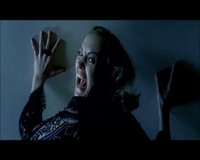 – probably in response to the canine lycans. This is best shown when Erika (Sophia Myles) sees that Michael has been bitten by a lycan. She leaps to the ceiling, fangs extended, and hisses like a cat (see screen cap). It also has marvelous set pieces, such as Selene shooting around her own feet in order to fall through the floor to escape charging lycans. Unusually the lycans look really good; most werewolves in film fail because the effects look poor.
– probably in response to the canine lycans. This is best shown when Erika (Sophia Myles) sees that Michael has been bitten by a lycan. She leaps to the ceiling, fangs extended, and hisses like a cat (see screen cap). It also has marvelous set pieces, such as Selene shooting around her own feet in order to fall through the floor to escape charging lycans. Unusually the lycans look really good; most werewolves in film fail because the effects look poor.
The film does fall flat in places, however. Some of the acting is awful, especially Shane Brolly as Kraven. The story is good and the plot rich, but that often gets misplaced within the set pieces. The extended aspect of the movie helps, with an extra 18 minutes, for example there is an entire sub-plot with Erika and Kraven that helps explain her motivations when she aids Selene.
In some respects you could say that the film is actually about class struggle. The vampires are decadent – when Selene first enters the mansion the gathering of vampires appear like they have just fallen out of Ultravox’s “Vienna” video – they are the bourgeoisie. The lycans are earthy creatures, practically forced to live in squalor having revolted against their slavery to the vampires – they are the proletariat. Yet, somehow, I don’t believe that the makers particularly considered this and any hint towards it was subconscious.
I love this movie, and therein lies the problem. In truth, despite plenty of plot, the movie is a victory of style over substance (and some occasionally risible acting). So, how to score this? This is a great action flick, even if it isn’t really great cinema, and I believe it deserves a respectable 7 out of 10.
The official site has trailers available.
The imdb page is here.
Posted by
Taliesin_ttlg
at
2:46 AM
2
comments
![]()
Labels: vampire, virus, werewolf, werewolf/vampire hybrid
Film and DVD Reviews A to M
Posted by
Taliesin_ttlg
at
2:42 AM
0
comments
![]()
Film and DVD Reviews N to Z
Posted by
Taliesin_ttlg
at
2:40 AM
0
comments
![]()
Saturday, May 06, 2006
Strange Things Happen at Sundown - review
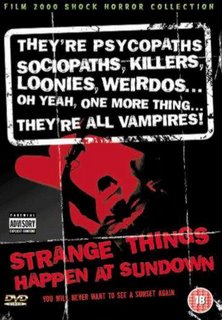 Director: Marc Fratto
Director: Marc Fratto
Release Date: 2003
contains spoilers
One of the best descriptions of this film is from the front of the UK DVD release:
“They’re psychopaths, sociopaths, killers, loonies, weirdos… Oh yeah, one more thing… They’re all vampires!”
Strange Things is a low budget film with big ambitions and, I swear, you will never have seen anything quite like it. A clever piece that, despite the title, has vampires who can go out in the daylight with no ill effect. The title is referred to during the film when the narrator of the piece informs us, “Something strange happens when the sun goes down. Like a calling to all vampires…”
The film begins with a group of vampires together, not only are they vampires but they’re also mob. We have Joey the Butcher (Joshua Nelson), Paulie Hands (Mike Massimino), Nicky the Tooth (Giovanni DeMarco) – so called as he can only produce one fang - and the leader Jimmy Fangs (Joseph DeVito). Here the brilliance of the film begins to shine through within the dialogue, given the mob connotation you cannot help but think Tarantino; the dialogue seems smooth and well put together.
Jimmy has invited Micky Balls (Joseph Anthony) and Fat Frankie (Sal Verderame) to Jimmy’s studio. They arrive with two girls, to be informed by Jimmy that he his taking over Micky’s drugs business. Guns are pulled and shots fired which leads to Joey being shot in the head. The vampires attack and feed on all four humans. Once a human is bitten the vampire’s venom (for want of a better word) hits their system. They are paralyzed, only able to writhe and sometimes scream. If their heart is not destroyed they will go through a painful, three day turning process, the paralysis seeming to wear off after a day or so which is when they start vomiting blood. It is not pretty and we see the process intimately during the film.
Jimmy orders Joey to destroy the four victims but Joey recognises one as Vicky (Melissa Bacelar), a friend of his sister and someone he wants. He talks Jimmy into letting her turn.
It is here that I will leave the blow by blow plot description and just give some overviews. The plot is fairly intricate but it goes something like this:
Jimmy realises that 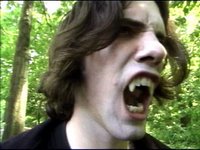 Marcel (J Scott Green) has ripped him off for $90,000. Marcel is on the run with his girlfriend Amy (Jocasta Bryan) and their car has broken down. A passing motorist tries to help and is devoured for his trouble; they kidnap his wife, born again Christian Annabelle (Shannon Moore).
Marcel (J Scott Green) has ripped him off for $90,000. Marcel is on the run with his girlfriend Amy (Jocasta Bryan) and their car has broken down. A passing motorist tries to help and is devoured for his trouble; they kidnap his wife, born again Christian Annabelle (Shannon Moore).
Jimmy is setting up a new drug, cannabis mixed with his own blood, which turns the user into a flesh-eating zombie slave, in order that he will create a ready army for his underworld business. He also has the worry that Paulie has been assassinated. Rather than track Marcel down himself, he enlists the help of the Reaper (Steve Gonzalez & Robert M Lemkowitz – voice), a cowled and robed assassin, to find Marcel and take him out.
A mysterious vinyl clad female assassin, who narrates much of the piece (Masha Sapron), is working her way through the vampire ‘community’ searching for one specific vampire. She seems, whilst only being one year turned, a particularly powerful vampire.
Amy seems to befriend Annabelle, much to Marcel’s disgust as he is holding her as a snack, and Annabelle is keen to try and convert Amy to the ways of the Lord.
Which is a pretty good summary of the main plot threads, I feel. This is not a simple film. When I’m reviewing these films I take notes. An average film ends up with maybe a couple of pages of notes, Strange Things had four pages. To reveal further where these threads go would be to do the film a disservice.
I have, however missed out one character. The Reaper, it is said, is old. He also lives in suburbia with his wife June (Livia Llewellyn). June  is 443 years old and keeps a very clean house; she also goes absolutely psychotic should there be the smallest mess in the house. It has to be seen to be believed. One nice moment comes in the fact that, during a psychotic screaming episode, June reveals that she used to be a Countess with a taste for virgins. Later the Reaper impales a victim and reveals that he hasn’t done that in some time. Nothing more is said but it led me to the conclusion that these two are Erzsébet Báthory and Vlad Dracul.
is 443 years old and keeps a very clean house; she also goes absolutely psychotic should there be the smallest mess in the house. It has to be seen to be believed. One nice moment comes in the fact that, during a psychotic screaming episode, June reveals that she used to be a Countess with a taste for virgins. Later the Reaper impales a victim and reveals that he hasn’t done that in some time. Nothing more is said but it led me to the conclusion that these two are Erzsébet Báthory and Vlad Dracul.
The filmmakers have drawn a world of psychosis around us, and they’ve done it well. Despite the low budget, clever camerawork and lighting ensures that sfx are, in the main, effective. There is also some nice use of filters within the cinematography.
The cast are very good. Not all the acting is brilliant, but all try hard and several of the performances are spot on. The gangsters might have just walked off a Tarantino set, and there is a soliloquy by Marcel that carries a huge amount of Pathos. This, of course, is helped by a decent script.
The soundtrack fits really well and, in short, you can tell that this film is a labour of love. I’ve watched it a few times now and I have got more out of it with every watch.
Now the warnings. The film is graphically violent and full of gore. It features (as the DVD box proudly proclaims) probably more writhing women than any other movie – and most of them are in agony and screaming. The script is excellent, but it is absolutely jam-packed with profanity. Let’s face it there aren’t many films that, having been given an 18 certificate also put a parental warning on the box. It all works, but if you are easily offended then walk away now. Oh, and when the box states it is around 90 minutes long, it lies, try around the 135 minute range.
Strange Things is a love it or hate it movie, I can see no middle ground. I loved it and am happy to give it 8 out of 10, and am left wondering just what these guys could come up with if someone was brave enough to give them a big budget and free-reign.
The official site has a couple of trailers on it, there are also a huge amount of vid-caps, which is where the two in this review came from.
The imdb page is here.
Posted by
Taliesin_ttlg
at
2:18 AM
2
comments
![]()
Labels: vampire
Friday, May 05, 2006
A proud moment
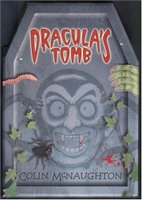
How proud was I, when I discovered that my young son's latest book, from the school library, was "Dracula's Tomb" by Colin McNaughton.
Glad to see that he's taking a healthy interest in such things... now only 9 years to go before I can let him watch many of the movies I love so much!
Posted by
Taliesin_ttlg
at
5:12 AM
0
comments
![]()
Vamp or Not? Planet of the Vampires

This is a 1965 movie directed by Mario Bava. On the surface things look promising with the film’s title and the trailer that declares “but attack like vampires,” leading us to believe that this is a vampire movie. However, it would be reviewed, rather than be in “Vamp or Not?”, if things were that simple.
We start aboard the starship Argos, one of two ships investigating a strange signal emanating from a planet called Aura. They are preparing to land, on ship to ship communication with the Galliant when things go horribly wrong. Communications fail and they loose control of the ship, the gravity rapidly increases rendering al the crew, bar Captain Mark Markary (Barry Sullivan), unconscious.
Somehow, however, the ship lands perfectly. On board, unfortunately, things are no so good. The crew has gone mad and are attacking each other. Mark manages to stop everyone from killing each other. They receive a distress call from the Galliant, which has also crash-landed, but the Argos does not have enough energy to take off and perform a rescue. Four of the crew set off across the hostile environment of the planet surface on foot. However, when they get there the crew of their sister ship have killed each other. Not only that but the Meteor Rejecter, used to deflect space debris, has been smashed by one of the crew. Four, including Mark’s brother Toby (Alberto Cevenini), are locked inside part of the ship. They bury the other dead and leave one guard whilst they get cutting equipment. On returning to the Galliant the guard is missing and so are the four dead bodies.
The crew return to the Argos and, once they have left, 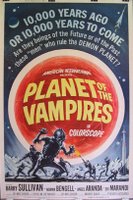 we see the dead crewmen rise from their graves.
we see the dead crewmen rise from their graves.
Back at the ship crewmen begin to die, often they see flashing lights on the periphery of their vision and one dying crewman, Mud (Stelio Candelli), says he was attacked by Captain Sallas (Massimo Righi) of the Galliant. As engineer Wes (Angel Aranda) tries to get power back, Mark takes a contingent to check out something they’ve spotted in a nearby valley.
They find a derelict spacecraft, with alien skeletons 3 times their size – sound familiar? This is another movie that must have influenced the creation of Alien (1979).
Sallas and another crewman find their way to the Argos, asking not to be shot. They talk slowly, but remember the names of the Argos crew. Their slow-speech is put down to shock and they are accepted, however they are not what they seem. They try, successfully, to steal the Argos’ Meteor Rejecter, but Sallas is caught, his uniform opening to reveal a bloodied mess of a torso. He admits he is no longer Sallas, he is the indigenous lifeform of the planet, an incorporeal being. They lured the ships there, like the alien ship before them, as their sun is dying and they need to escape the planet. They caused the crew, whilst they were unconscious, to fight and kill each other in order that they might possess the bodies – but they can possess a living, conscious host if they are willing.
The stranded astronauts accuse the aliens of being parasites but the aliens mention symbiosis. The race is on to steal back the stolen Rejecter and escape the planet.
The film is great fun and very atmospheric – as you would expect from a Bava film. The effects aren’t bad given when it was made and it seems that Bava combined live action filming with miniature sets by reflecting the sets through a mirror, with portions of the reflective surface scraped away so that the actors could be seen through it. Now that’s innovation. There is even a very neat twist at the very end that, today, we would probably call clichéd but, given when it was made, was excellent.
The film uses techno-babble to the max and there are readily apparent plot holes such as: if the ships need the  Meteor Rejecter so much, why on Earth was the Galliant’s destroyed when the crew went mad, given they were possessed by the aliens who wanted to escape the planet? Yet the film captures you so completely that you just don’t care, and that has more than a little to do with the atmosphere that Bava is able to inject into his movies.
Meteor Rejecter so much, why on Earth was the Galliant’s destroyed when the crew went mad, given they were possessed by the aliens who wanted to escape the planet? Yet the film captures you so completely that you just don’t care, and that has more than a little to do with the atmosphere that Bava is able to inject into his movies.
But is it a vampire movie? Frankly, no, and it is a great shame as it would have been a good one. The film has possession elements, zombie overtones and even slight tinges of body-snatchers but no vampires. Just one feeding scene, as the trailer promised, and I might have conceded its vampness. Possession by an invisible entity does not make a film a vampire movie, nor does rising cognisant from the grave, if the cognisance comes from an alien force - indeed they make it very clear that, whilst the aliens can access the memories of the dead crewmen, there is nothing of the original person left. With a few changes the film might have proven a basis for another form of vampirism, but not in the way it was done.
This is a good 60’s sci-fi, complete with leather jump suits that wouldn’t have looked out of place in a Flash Gordon episode and, as a movie, I thoroughly recommend it. Just do not expect any vampires.
The imdb page is here.
Posted by
Taliesin_ttlg
at
12:32 AM
0
comments
![]()
Wednesday, May 03, 2006
Eternal - review

Director: Wilhelm Lieberberg/Federico Sanchez
Release Date: 2004
Contains spoilers
Eternal begins with the legend, “the following story was inspired by true events.” By that the producers mean the historical antics of Erzsébet Báthory and not what happens within the film, which is, shall we say a little far fetched. It seems strange to say that in a review of a vampire movie, but the real world touches that might have drawn one in to this are sadly fantastical.
The film begins with a woman called Jessica (Sarah Manninen) – known in a chat-room as Wildcat - driving to a mansion in Montreal. The place is opulent, and one thing this film does do well is use beautiful scenery and locations. She is there to have a liaison with Elizabeth Kane (Caroline Neron) – a woman she has met on the internet and intends to have an illicit lesbian tryst with, behind her husband’s back. There is a little bit of wine drinking – note to self, if I am ever in the situation of meeting a stranger, who lives in a mansion, and toasts with the words, “To eternity,” run: it’s bound to be a vampire – a little touchy, feely and then Elizabeth slips on a silver finger sheath and pierces Jessica’s neck.
There follows a soupcon of blood drinking and then Elizabeth’s maid Irina (Victoria Sanchez) comes in and is told to prepare Elizabeth’s bath. First thing to note is, no fangs – that’s to be expected in a vampire movie based on the Báthory story – and the second thing is that Elizabeth is obviously Erzsébet, still going strong centuries on.
Unfortunately, Jessica’s husband was bad boy cop  Ray Pope (Conrad Pla) and it is here that the film begins to unravel. When we first meet Pope he is having some bondage sex with a woman – who turns out later to be Nancy (Ilona Elkin), his partner’s wife – and during gets a call about his wife’s car being found. She’s been missing two or three days, but that doesn’t seem to matter up to that point. Pope, and all the other characters, are thoroughly disagreeable and so no sympathy is developed for any of the characters within the film. Pope quickly finds a connection between his wife and Elizabeth (a woman with no fingerprints it seems) and things begin to unravel in his life.
Ray Pope (Conrad Pla) and it is here that the film begins to unravel. When we first meet Pope he is having some bondage sex with a woman – who turns out later to be Nancy (Ilona Elkin), his partner’s wife – and during gets a call about his wife’s car being found. She’s been missing two or three days, but that doesn’t seem to matter up to that point. Pope, and all the other characters, are thoroughly disagreeable and so no sympathy is developed for any of the characters within the film. Pope quickly finds a connection between his wife and Elizabeth (a woman with no fingerprints it seems) and things begin to unravel in his life.
He is eventually framed for the murder of Nancy and the rape and murder of his young babysitter, his sperm being planted - in respect of the rape - as he had sex with Elizabeth. There is an interesting sub-plot with Irina having been promised initiation into Elizabeth’s lifestyle and murdering young boys with false, razor-sharp teeth, but it isn’t really developed and certainly reaches no form of conclusion. There is the indication that, for the vampire to maintain her youth, to kill is not enough and that the victim must be seduced and must be willing – an unwilling soul cannot be taken – which was a nice touch.
Anyhoo, Elizabeth takes off to Venice and somehow Pope follows her – remember he’s wanted in connection with his disappearing wife, the murder of another cop’s wife and the rape and murder of a minor (or was she, the detective’s who fish her out of the river seem to think so but I don’t know of many minors who can baby-sit during week days and fix cars). How he got out of Canada and all the way to Venice is a mystery, though at the end of the film there is a hint that perhaps he had, unknowingly, been helped by Interpol or perhaps it was the Vatican secret service!
A showdown is now, of course, inevitable. I will say that the  ending was a little unusual, not what I might have expected. The only problem with it was that it opened the door for an Eternal 2, and I wouldn’t want to meet these characters again – then again I wouldn’t want to watch the ending of this film be glossed aside as so often happens between a film and its sequel.
ending was a little unusual, not what I might have expected. The only problem with it was that it opened the door for an Eternal 2, and I wouldn’t want to meet these characters again – then again I wouldn’t want to watch the ending of this film be glossed aside as so often happens between a film and its sequel.
My description of the film might seem glib, but I really struggled to enjoy this one. The situation never grabbed me and, as I said, I couldn’t have given a hoot about any of the characters. My mind actually wandered and I began to question, whilst Pope was in Venice, who was looking after his son – given the babysitter was dead.
It is a real shame, because the script did contain some good concepts and the locations and sets were, as I said at the head, quite sumptuous. Yet, I can only give this 3 out of 10; I’ve seen productions with no real locations and no budget that have grabbed me and held me – this didn’t and production design is nothing if the story and characters do not hold you. The reality of this problem comes up in the production notes found on Rotten Tomatoes:
Completing the adventure in locations was the final scene in the monastery. They scouted for a suitable location and the Abbazia San Pietro in Valle, Valneria was the one they wanted. The only one. The problem was that this was an operating monastery and the script for the scene to be shot had to be rewritten to suit the Vatican. A new script was produced, the Vatican approved, and the cast and crew were in and out in one day.
If you have so little script integrity that you will change it for a location, especially one so little used in the film, then your script has real problems. I don’t know the extent of the change, but I do know that they could have found other suitable locations, to me the script has to be more important than the location. Finally I should point out that there are strong sexual themes throughout the movie, as you would expect, but they weren’t particularly erotic - Franco has done much better with much less.
There is an official site here with a trailer.
The imdb page is here.
Posted by
Taliesin_ttlg
at
11:22 PM
2
comments
![]()
Labels: Erzsébet Báthory, vampire
Dracula Blogged

For those who have not read the classic Stoker novel, or indeed for those who have, the excellent blog site Dracula Blogged are re-running the blog of the novel, following the dates of the various diary entries in the novel, starting today.
Expect not only the novel, but many insightful and thoughtful aspects of commentary.
The pic above is, of course, Bela Lugosi in his famous role as the Count.
For those wondering why Dracula has not appeared in the Classic Literature section of this blog, the answer is simple. I'm still puzzling over how I can cram a description of the genius of the novel, plus précis the influence it has had, into one small blog piece!
Posted by
Taliesin_ttlg
at
1:58 PM
0
comments
![]()
The Twins Effect - review
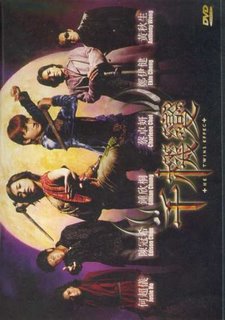
The Twins Effect
Director: Dante Lam & Donnie Yen
Release: 2003
Contains spoilers
A few things to note about this film, this is a Hong Kong vampire movie, however unlike such films as Mr Vampire (1985), this is not a typical Chinese vampire story, the vampires being more Western in style. Secondly the review is of the Hong Kong version, which is slightly longer than the UK version and was released under the title “The Vampire Effect”. Final thing to note, is that there are no twins in the film, the title refers to the two leading actresses, Charlene Choi and Gillian Chung, who were in a canto-pop duo called the Twins.
The film starts in a near deserted train station at night. Two people watch the platform from above, Reeve (Ekin Cheng) and Lila (Josie Ho). Bats fly into the station and Reeve drinks something from a vial, telling Lila to wait for him – as dangerous work is a man’s work – he jumps down to the platform and boards a train which has pulled up. Lila is attacked in the balcony area as Reeve starts fighting hordes of vampires on the train. Interestingly the vampires dust, much like those in Buffy or the Blade movies (1998 - 2004). Eventually they both end up on the platform fighting a western vampire, whom we later discover is called The Duke (played with some gusto by Mickey Hardt). They do not defeat the Duke but Reeve takes his arm and it is clear that Lila is injured.
A voice-over as Reeve carries her away indicates that she has died, she was his third partner in the anti-vampire league and he loved her, he vows never to love a partner again.
Next we see a girl meet four people outside a church. She is real estate agent Miss Momoko (Mandy Chung) who hopes to rent the church to Kazaf (Edison Chen) and his servant Prada (Anthony Wong Chau-Sang). Instead they buy the place. Kazaf is a vampire Prince who will not “suck” humans. There is a scene where Momoko has some form of insect (mosquito?) on her neck and squashes it, causing an open wound. The two vampire women with Kazaf present fangs behind her back but are called back by Prada. I mention this scene because I want to quickly examine the visual differences between the good vampires and bad. Whilst not exactly consistent, all the bad vampires have mouths filled with fangs and the Duke has red eyes. The good vampires seem to have the two traditional fangs and icy blue glowing eyes. Just an interesting visual touch.
Later, in a restaurant, a man is accosted by his ex-girlfriend Helen (Charlene Choi), Kazaf becomes involved and gets Helen’s number – he is very taken with the sassy young girl. Reeve then meets his new partner at the airport, Gypsy (Gillian Chung). It happens that Helen is Reeve’s sister and she and Gypsy do not get on.
We then find out the rules of vampirism and the main storyline. The vampires cannot go out in the day, they must drink blood. The Duke has rebelled against the royal family and is stealing their essence in order to open the book “day for night”, which contains the blood of the ultimate vampire and can give daywalking abilities. Kazaf is the last Prince and has been sent the book. To fight vampires the human’s must consume vampire blood, this gives them vampire strength for about an hour and a half and then they must take an antidote, that Reeve hides as banana essence – because Helen hates bananas.
The film then goes through a series of comedy and “date movie” moments that actually work really well, as Gypsy and Reeve get to know each other – and Gypsy falls for him, and Kazaf and Helen develop their relationship. One stand-out moment is when Kazaf puts on mystical oil in order to go out in daylight to date Helen. The reason for mentioning this is because they end up gate-crashing the wedding of Jackie (Jackie Chan) in an amusing comedy moment that sees Helen giving Jackie a ring from Kazaf’s finger – the wedding ring is missing – and the ring mark setting on fire as it has no oil on it; attention to detail like this makes this movie. This is not a stand alone scene and they meet Jackie again, in his job as a paramedic – cue a Jackie Chan stunt fight comedy moment.
There is also the obligatory, it seems, hero almost turning into a vampire moment with Reeve. He looses his antidote – picking up banana essence instead. Rushing back home he and Gypsy discover that Helen has been baking banana cake (with the antidote) as Kazaf, to pass for human, has said he enjoys bananas.
The film becomes deadly serious again towards the end, with a massive wire fight. It must also be said that it is set up for a sequel and got one, kind of. Twins Effect 2 (2004) is nothing to do with the first film, being more comedic and a period piece with different characters. It seems the mainland Chinese authorities disapproved of the concept of a vampire movie – though that might just be imdb speculation.
The film has its problems. The Jackie Chan bits are good, but can feel like they were added in order to get his name in the credits. There is at least one moment of blatant product placement. Never-the-less the film manages to skilfully blend, comedy, action and romance and intermingle western style vampires in a Hong Kong movie. I’m going to give this 7.5 out of 10, but you must be prepared for a slapstick comedy with some high octane action elements. Some have said the movie looses something on the second watch, but I re-watched this for the review and still enjoyed it.
The official site is here, it is a flash page with menu’s in English but the substance in Chinese. However it does carry a couple of trailers.
The imdb page is here.
Posted by
Taliesin_ttlg
at
4:27 AM
0
comments
![]()
Labels: vampire
Tuesday, May 02, 2006
Music: The Rohan Theatre Band
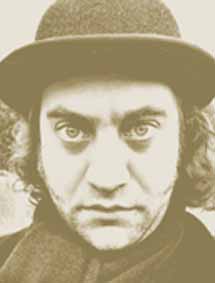
The Rohan Theatre band are the brainchild of Rohan Kriwaczek. I thoroughly recommend you nipping over to the site to discover some unusual and inspiring music. The page has several pieces streaming through a player, and the music is pretty darn unique, though it does carry a touch of the Tom Waites with touches that are more than a little Eastern European in origin. As the site says: “collections of dark and often sleazy songs with instrumental accompaniments.”
The vampire connection? Check track 12 on the player, "Johnny Vampire"; a black humoured look at someone who believes himself to be a vampire. The band’s cds are available, from the site, at a bargain £6.00 + £1.00 P&P each.
Thanks to Mick Mercer's live journal for pointing me in Rohan’s direction.
Posted by
Taliesin_ttlg
at
3:19 PM
0
comments
![]()
Queen of Blood - review

Director: Curtis Harrington
Release date: 1966
Contains spoilers
What can I say about this film, but what a little gem. This is a low budget sci-fi flick with big ambitions. A lot of the stock effect scenes were taken from the Soviet movie “Nebo Zovyot” (1960), but added seamlessly into the film and the cast is superb. Also note that horror staples Samuel Z. Arkoff and Roger Corman were involved in this as Producer and Executive Producer respectively.
The year is 1990, man has bases on the moon and is preparing for trips to Mars and Venus when a signal is received from an alien planet – they are to send an ambassador to earth. A probe arrives and the pictures it contains tell chief scientist Doctor Farraday (Basil Rathbone) that the alien ambassador has crashed on Mars. The starship Oceana was due to visit Mars for the first time in 6 months but the project is brought ahead of schedule. On board are Commander Anders Brockman (Robert Boon) and astronauts Laura James (Judi Meredith) and Paul Grant (Dennis Hopper). The ship encounters trouble, in the form of a sunburst, but is able to land. They find the alien ship, but only one dead astronaut.
Allan Brenner (John Saxon), Laura’s fiancé, suggests that they take a smaller ship, the Meteor, to launch search satellites to look for a rescue pod. The Meteor has less fuel capacity so they would then have to land on Phobos and take their own rescue ship to Mars. They do this but find the alien rescue pod on Phobos. Flipping a coin, fellow astronaut Tony Barrata (Don Eitner) is left on Phobos to await further rescue as they have found a survivor (Florence Marly) and their pod can only take two.
The build up to this point is rather slow in places, Harrington doing his best to draw a real world around us, but perhaps gets lost in minutia – but hereafter the film really kicks up a gear.
The alien is listed on imbd as “Alien Queen” but the films credits call her “?”. She has green skin,  pointy silver hair and a very tight fitting suit. She never speaks and all emotion is portrayed in facial gestures – it is clear she does not like Laura. As they return to earth Paul gets her to drink but cannot get her to eat, they want to test her blood but she is afraid of the needle. Then, whilst on shift alone, she approaches Paul. Her eyes glow hypnotically silver and she attacks. In the morning Paul is found dead, his body drained of blood and wounds are on his wrist. It doesn’t take them long to realise what has happened as ? is in deep sleep, digesting her meal, with blood round her mouth. Allan wants to destroy her but Anders steps in the way, he suggests that they feed her plasma from their supplies and, back on the moon, Farraday agrees. Interesting to note that they refer to her always as a specimen, and doing tests on her when back on earth.
pointy silver hair and a very tight fitting suit. She never speaks and all emotion is portrayed in facial gestures – it is clear she does not like Laura. As they return to earth Paul gets her to drink but cannot get her to eat, they want to test her blood but she is afraid of the needle. Then, whilst on shift alone, she approaches Paul. Her eyes glow hypnotically silver and she attacks. In the morning Paul is found dead, his body drained of blood and wounds are on his wrist. It doesn’t take them long to realise what has happened as ? is in deep sleep, digesting her meal, with blood round her mouth. Allan wants to destroy her but Anders steps in the way, he suggests that they feed her plasma from their supplies and, back on the moon, Farraday agrees. Interesting to note that they refer to her always as a specimen, and doing tests on her when back on earth.
The plasma runs out and Anders' plan is to give her their blood donated by the crew in a none lethal fashion, however this plan never comes to fruition as Anders finds himself attacked and killed. The next morning Allan ties her up.
He is on shift, with Laura sleeping, when ? awakens. She uses her hypnotic eyes to burn through the rope. Laura wakes and finds Allan being  fed upon, she fights with ? and scratches her, which causes ? to scream and run. They find her dead – she has chronic haemophilia - hence being afraid of the needle earlier. When they land on Earth they realise that ? has secreted eggs all over the ship. Allan wants to destroy them but is overruled by Farraday who wants to study them. Here the film ends, with a shot of jelly like eggs and Allan’s warning that she was not an ambassador but had been sent to Earth to colonise us as a feeding ground still ringing in our ears.
fed upon, she fights with ? and scratches her, which causes ? to scream and run. They find her dead – she has chronic haemophilia - hence being afraid of the needle earlier. When they land on Earth they realise that ? has secreted eggs all over the ship. Allan wants to destroy them but is overruled by Farraday who wants to study them. Here the film ends, with a shot of jelly like eggs and Allan’s warning that she was not an ambassador but had been sent to Earth to colonise us as a feeding ground still ringing in our ears.
The cast obviously loved making this film, especially Rathbone who is marvellous as Farraday and most interesting is the similes that can be pulled to the classic sci-fi/horror movie “Alien” (1979). The elements from “Alien” are all their from the distant signal, the need of the scientists to posses the creature, the picking off of crew members and the depositing of eggs (admittedly more to do with “Aliens” (1986)) it is impossible to think that this film had no influence on Dan O’Bannon when he wrote the script for his opus – even if it were only subconscious. The big difference was that the creature was a space vampire, and vampire she certainly was - this is a prime example of the vampire being an alien creature rather than a supernatural creature.
Scoring this is difficult. Many will be lost within the kitsch that makes up the look of the film, but given when it was made that can be forgiven. However the start of the film does become bogged down in minutia that perhaps is not needed. After thought I settled on 7 out of 10, but must add that I did thoroughly enjoy this and anyone who loves 60s sci-fi should get something out of this.
The imdb page is here.
Posted by
Taliesin_ttlg
at
2:46 AM
4
comments
![]()
Labels: alien vampire
Monday, May 01, 2006
Vamp or Not? Atom Age Vampire
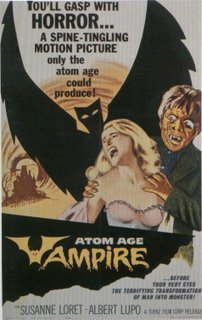 Released in 1960, “Atom Age Vampire” begins with an argument between Pierre (Sergio Fantoni) and Jeanette (Susanne Loret). He is leaving her because she won’t give up her job – never fully explained but I presumed a club singer, though other people have suggested a stripper. Upset, she drives away and crashes, the car bursting into flames. The accident leaves her horribly disfigured on one side of her face. She wishes to kill herself but is persuaded to go secretly to Professor Alberto Levin (Alberto Lupo) by his assistant Monique (Franca Parisi Strahl).
Released in 1960, “Atom Age Vampire” begins with an argument between Pierre (Sergio Fantoni) and Jeanette (Susanne Loret). He is leaving her because she won’t give up her job – never fully explained but I presumed a club singer, though other people have suggested a stripper. Upset, she drives away and crashes, the car bursting into flames. The accident leaves her horribly disfigured on one side of her face. She wishes to kill herself but is persuaded to go secretly to Professor Alberto Levin (Alberto Lupo) by his assistant Monique (Franca Parisi Strahl).
Levin has been working on a way to cure physical disfigurement, primarily to save the victims of Hiroshima. He developed an agent called Derma 25 which produces horrible disfigurement on the skin and has gone on to produce, from it, Derma 28 – this should repair disfigurement but has not been tested on humans. Monique injects herself with Derma 25 and Levin wants to give her radiation treatment, she convinces him to give her Derma 28 and it removes the disfigurement.
They give Jeanette five treatments with Derma 28, to no avail, and then it begins to work, her face returning to how it was before the crash. Levin falls in love with Jeanette, much to the chagrin of Monique, but then the treatment begins to revert. Unfortunately Derma 28 takes months to produce and he can't wait that long, so he realises that he must transplant the gland that naturally produces Derma 28 into Jeanette from another woman and murders Monique for the gland. Unfortunately the treatment, again, does not hold.
He ends up injecting himself with Derma 25, transforming into a hideous beast, in order to murder women to treat Jeanette and then reverting back to normal with radiation treatment. At the same time Jeanette, who does not love Levin, wishes to escape from him and Pierre searches for his missing love.
The film is a mad scientist movie, with more than a touch of Jekyll and Hyde about it, but is it a vampire movie? After all it appears on many a vampire filmography list and has the name vampire in the title.
The film itself is a bit of a mess, the original Italian release was 105 minutes long, but the US release was cut down to 87 minutes and the dubbing is awful. There is so much melodrama in the English voice-overs it almost drips with it. The film is also, unfortunately, fairly boring with little atmospheric build up. But that’s not what we are looking at.
The search for youth is a bit of a vampire sub-genre. Treatments with blood played a role in Nightmare Castle (1965) and bathing in blood to regain youth is the theme of “Countess Dracula” (1970). However key here is the element of blood, but that said many vampire stories have the vampire hungering for substance other than blood. Another element of those other films was the recipient of the treatment knew what they were doing – Jeanette is unaware of the murders in this and would probably be horrified at the thought that women were dying to provide her beauty.
There is mention of vampires in the movie. The police are hunting for a killer known as Seddok – something which killed during the film and that Levin uses as cover for his own monstrous attacks. The police inspector (Ivo Garrani) asks Levin if the killer could be someone arrived on a recent ship from Japan who has been disfigured in the Hiroshima blast, a “vampire of the atomic age” who murders because he wants to recover from his injuries. Levin dismisses the theory as melodramatic – ironic given the melodrama I’ve mentioned that drips from the movie.
The strongest vampire motif is in the opening credits when we see an animated bat that turns into the V from vampire in the title - not a good reason to call this a vampire movie. I can see why this film ends up on vampire lists, but I do not think the elements are strong enough to class this as a vampire movie, personally. Had the treatment involved blood and had Jeanette been complicit in the treatment I might have been tempted otherwise. This film is public domain, however, so you can download it and check for yourself via The Archive. A word of warning, however, that I couldn’t get the download of the large Mpeg 2 file to work - it would crash about 800 megs in, even with a download manager, so I’d aim for a smaller file.
The imdb page for the film is here.
Posted by
Taliesin_ttlg
at
3:23 AM
0
comments
![]()
Labels: created by science, genre interest, vampire














